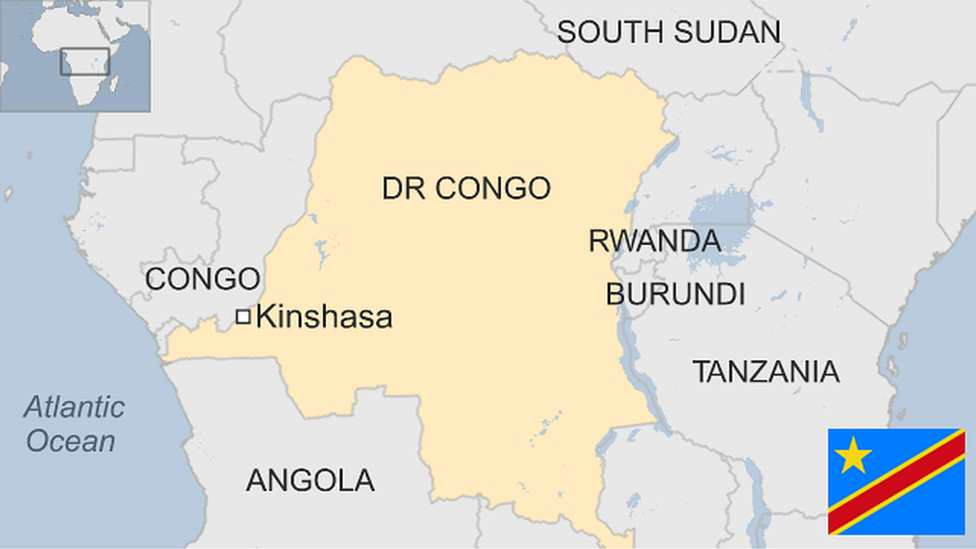Opinion: The Bloody Impact of Conflict Diamonds in the Democratic Republic of the Congo

Map and flag of the Democratic Republic of the Congo (Map from BBC)
Editor’s Note: This article is the second in a new opinion series by the Anti-Racist Collective, a student organization seeking to “deconstruct racial discrimination on campus.” This series is titled “World Conflicts & Humanitarian Exigency.”
By Sophia Rodriguez, Guest Columnist
Blood diamonds, also known as conflict diamonds, are defined by the United Nations (UN) as diamonds mined in areas controlled by forces opposed to the legitimate, internationally recognized government of a country and sold to fund military action against that government. The diamond trade has fueled multiple civil wars, most notably in African nations such as Angola, Sierra Leone and the Democratic Republic of the Congo (DRC).
The DRC is one of the world’s richest countries in terms of natural resources, yet it remains one of the most conflict-ridden due to the exploitation of these resources, which has been largely attributed to the role of the illegal diamond trade. Diamonds mined in rebel-controlled areas are smuggled into neighboring countries, where they are merged with legally mined stone to then enter global markets. The profits gained from these sales are used to acquire arms and war matériel, escalating conflicts and leading to severe humanitarian crises. Furthermore, the wealth generated from blood diamonds enables these groups to maintain their power and continue their brutal campaigns, exacerbating instability in the region. This has had devastating consequences for civilians in the DRC, leading to the deaths of millions, primarily due to violence, disease, and starvation as well as immense human suffering, including displacement, sexual abuse, use of child soldiers and other human rights abuses.
In response to growing global outrage over conflict diamonds, the UN, human rights organizations, and the diamond industry established the Kimberley Process Certification Scheme (KPCS) in 2003. The Kimberley Process was designed to prevent conflict diamonds from entering the legitimate diamond trade by requiring diamond-producing countries to certify that their exports were conflict-free. While the Kimberley Process had some success in reducing the number of blood diamonds on the market — dropping their share from an estimated 15% in the 1990s to less than 1% by 2010 — it has faced significant challenges. Smuggling and fraudulent certification continue to undermine its effectiveness, particularly in the DRC, where weak governance and corruption enable illicit diamond trading.
Even though many of the African civil wars fueled by blood diamonds have ended, their consequences continue to affect millions of people. For instance, in the DRC, it is estimated that since 1996, the conflict has led to approximately six million deaths. Furthermore, there are more than 100 armed groups still active in eastern Congo’s provinces, with one of the most predominant groups being the March 23 Movement (M23). Contemporarily, the proliferation of mining operations, particularly of metals and rare earth minerals like cobalt, copper, and zinc are used to produce electronics, which has complicated peace efforts and fostered an environment for rampant human rights abuses, corruption and conflict.
With this in mind, it is fundamental to highlight the role of consumers in the blood diamond trade and the purchase of electronic devices that source materials and minerals from conflict-ridden areas. The film Blood Diamond (2006) highlights the industry’s dark realities, emphasizing how consumer demand in Western countries has perpetuated the cycle of violence, emphasizing how greed and the desire for luxury have driven exploitative practices and human suffering in Africa.
At the end of the day, through our consumption choices, we are also responsible for contributing to cycles of violence and human suffering. By educating ourselves and others on these issues we can minimize the hold of these exploitative markets on conflict-ridden areas. Furthermore, there is a need to advocate for greater accountability in terms of institutions, and to promote ethical sourcing. While international efforts such as the Kimberley Process have reduced the prevalence of conflict diamonds, there are still significant challenges that remain. Finally, the DRC demonstrates the urgent need for sustained global action to prevent future conflicts driven by greed and exploitation.
Resources that Provide Assistance:
Project World Impact: Website that includes links to various nonprofit organizations that support the DRC. Also has information on the DRC and different issues that it faces (including environment, religion, human rights, education, poverty etc.), as well as links to more resources such as relevant news articles.
Virunga National Park: Link to the National Park website. Virunga National Park is Africa’s oldest National Park. Donations help restore key habitats, protect vulnerable gorilla populations and monitor the Park’s diverse wildlife. This sector has been severely affected by the ongoing conflict (see Virunga for more information).
Virunga Shop: Support local initiatives by buying from store like this which strengthen local communities and prevent illicit trade. In Eastern DRC, conflict and instability have threatened local farmers. This exploitation deprives communities of their livelihoods and fuels further unrest.
Films for Further Education:
City of Joy, Virunga, Blood Diamonds, War Witch, & This Is Congo
